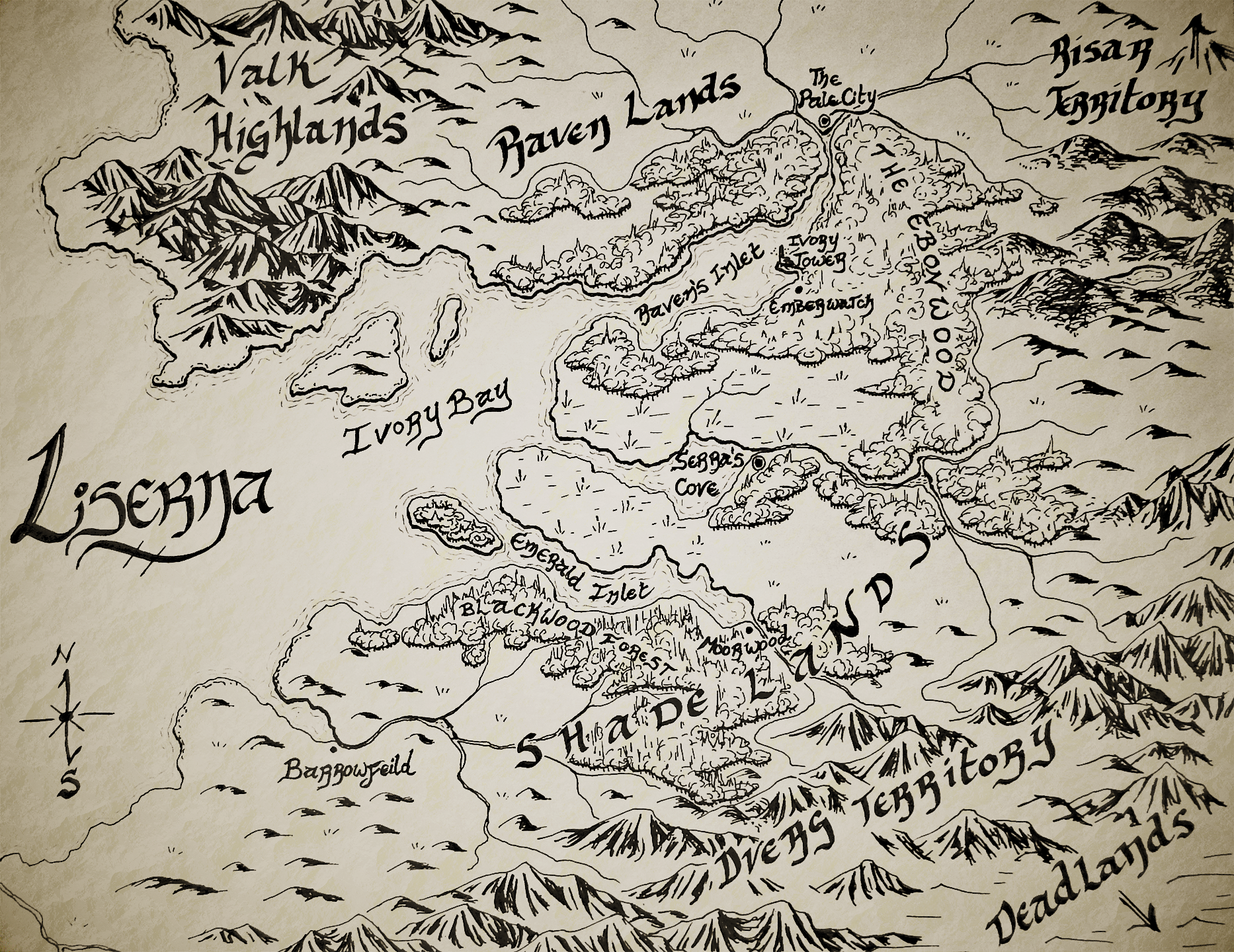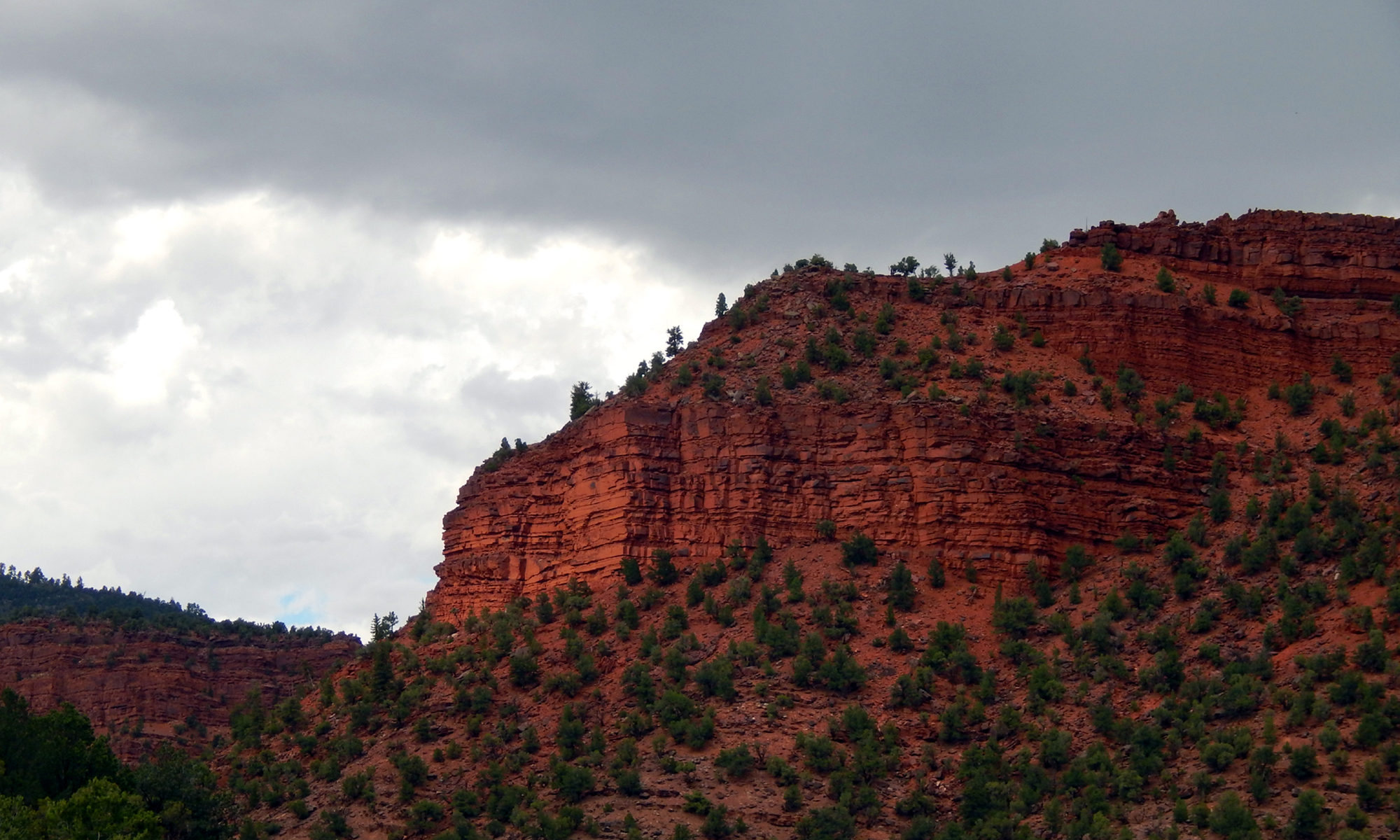
Synopsis
The Spirit Realm, the Western Realm, where beings of the realm of Omnia go when their spirits leave their bodies (aka, death). It is the harmonic opposite of Oberun, which means that natives to that realm cannot exist in Liserna for very long without great discomfort. The beings who live here do have limited lifespans, like Mortals, though in vastly different ways. The most widely spoken languages in the established world are Spiritspeech, which is spoken widely in Liserna and among Omnian undead, and Serranian, spoken mainly by Shades and Valkurjar.
Lands
Liserna is characterized by one landmass and one global ocean, and most of that landmass is considered uninhabitable due to Val-Serra’s experiments with Red Necromancy in the Dawn Era. The land mass is generally called by the same name as the realm, and the ocean is simply, “the ocean.” The sky here is green, and the plants are generally dark, in varying shades of reddish, blue, and violet. If there are any green plants on Liserna, they aren’t native to it, and many of Omnia’s dark-shaded plants actually came from here, and were able to survive, such as weeping junipers, red stonecrop, barberries, sand cherries, and cordyline.
Some herbs that come from Liserna are non-poisonous to outsiders, including Shade Basil (which looks similar to Thai Basil), chamomile, white sage, and chocolate mint, all of which adapted green leaves in Omnia, from their blueish Lisernian counterparts. Other herbs, usually imported for their color, or on accident, are highly toxic to folks not native to the Spirit World. These include wolfsbane, nightshade, and hemlock, all of which have black leaves in Liserna. Strangely (at least, to people of the other Realms) native Lisernians use these herbs for medicinal, magical, and even culinary purposes.
Animals on Liserna are generally prehistoric looking (or they would be to us, anyway), and are generally well adapted for the environments they live in. There is a great deal of megafauna, including cave bears, wooly mammoths and mastodons, dire wolves, aurochs, muskoxen (a favored herd animal of the Dvergar), reindeer, moose, ice lions, and dire boar. Tiny mammals also scamper around the Lisernian undergrowth and burrow in the plains and hills, including jackalopes, cats, swamp deer, various rodents, maned foxes (not maned wolves, but literal foxes with big, fluffy manes), and tanuki. There are also several varieties of reptiles, including drakes, monitor lizards, and snakes, some amphibians, like turtles, frogs, and toads, and all manner of bird species, including but not limited to: sea birds, corvids (which are actually native to Liserna and migrated to other Realms, nobody knows quite how), owls, small songbirds, and large carrion eaters like vultures and condors. There are also said to be strange, twisted creatures that linger in and around the Deadlands and deep forests, with names like Spindle Striders, Murk Lurkers, and Shadow Eaters. Make of those what you will.

Countries
-
The Raven Lands:
Theocratic Monarchy, ruled by the Raven Queen and/or the Raven King, who preside in the Ivory Tower. All dead souls eventually reach the Tower, and from there their Fate is determined. The main inhabitants of the Raven Lands are Ghosts, though some other races stop in every once in a while for trade. The first one too rule from the Ivory Tower was actually Raven King Runel, who caused the animosity from the Shades that resulted in a boundary being proclaimed. Before that, the seat of power was in what is now the Shadelands, where the First Raven Queen, Val-Serra, ruled with a gentle hand.
-
The Shadelands
Socialistic Gerontocracy, ruled by the elders of various clans. While they don’t have clans in the traditional sense of the phrase, they have extended families tied together by their sigil, or tattoo. For example, the clan Whitebarrow’s sigil is an aspen tree with an arched doorway in the trunk. The elders from the clans get together once every new moon to discuss what would be best for the younger generations. Technically only Shades are part of the Shadelands, though members of other races also live there. They aren’t viewed as second-rate citizens, just general outsiders, and are given the same respect and opportunity as a Shade of the same standing.
The capital of the Shadelands is Serra’s Cove, which used to be the capital of Liserna, before Runel moved his rule to the Ivory tower. Val-Serra, the First Raven Queen, ruled from Val’s Keep, which is the center point of the town, and is now mainly used as the meeting place for the Elders.
Librarians and Scribes are highly valued in the Shadelands, as usually there are one or more of them in attendance at the Elders’ gatherings in order to keep track of the goings-on and to preserve the living history of their people. In fact, many Shade librarians go out into other realms, sometimes at the risk of great peril, to copy down religious texts, historical documents, and other stories.
-
The Valk Highlands
Home of the Valkurjar, it is a mountainous region that extends north toward the equator, and into more tropical climate. Because the Valkurjar tend to keep to themselves, and even have their own language which is generally unintelligable to other Lisernians, not much is known about them, their lands, or their culture. Their terrifying appearance often keeps people away as much as the terrain does.
-
Dverg Territory
A stretch of high peaks that separate the Shadelands from the Deadlands, in which the Dwarves make their nomadic homes, driving or following herds of muskoxen and aurochs through the valleys and sometimes up into the alpine tundra. Because the mountains of the Dvergar are considered sacred to them, nobody has ever been allowed to mine them, including the Dverg themselves.
-
Risar Territory
Lowland mountains and rolling plains that extend northeast of the Raven Lands, over which the many tribes dispute territory and sometimes live in peace. The Risar aren’t as nomadic as the Dverg, but they do have a wandering streak, and sometimes entire encampments from one tribe or another will up and leave to find greener pastures, or get away from the encroaching forces of other tribes.
People
The native races of Liserna do not have a collective name, given the wide variety of lives they live. This includes Risar, Shades, Dwarves, Ghosts, and Valkurjar. Generally, these races do not intermix with each other, save for the occasional mix between a Risann and a Shade, or a Shade and a Dverg. Ghosts are incapable of reproducing, and Valkurjar are so genetically different that to try with any other race would be futile.
- Risar stand roughly 7 to 10 feet tall, and are built lean but muscular. They are a very androgynous race, with almost no way to tell a male from a female but for their reproductive organs(which still isn’t always trustworthy on first glance) and their own personal say-so. Gender expression in their culture largely depends on relationship dynamics. Many Risar are skilled in the art of shape-shifting, usually into animals, or animal-humanoid hybrids, and have formed clans based on various powerful animals over the centuries. They are a visually diverse race, despite the androgyny, often taking on characteristics of their “bond-animal,” that is, their shapeshifted form of choice, as they age. Risar generally live to be about 150 years old.
- Dwarves (or Dvergar) stand from 3 to 5 feet tall, and are generally built wide and strong. They have nearly black skin and hair, and eyes in all colors that shine like gemstones. They live in high altitudes, generally all the way up the tops of mountains where the air is thin and cold, and the sun is dangerous. They are nomads, herders, and occasionally settle down into farming villages is the valleys, though these are usually temporary as well. Male Dwarves typically grow long beards and long hair to protect them from the wind and cold, and females do the same, just lacking the beards. Due to the harsh environment, which sometimes strays into the Deadlands, Dwarves only live to be about 80 years old.
- Shades (or Svartnar) stand about 4 1/2 to 6 feet tall. They are physically similar to Humans and Elves, and can reproduce with both, though the latter is beyond rare. Their skin ranges from paper-white to a dull tan, with hair usually black or dark brown, even straying into shades of dark violet and blue. Some Shades pale their hair or sections of it, generally in accordance to personal taste, and almost all of them have tattoos indicating clan, name, occupations, and sometimes life events like periods of grieving or great accomplishments. They live to be around 100 years old regularly, and the older the Shade, generally, the more tattoos.
- Ghosts (or Draugar) are the souls of the dead from other Realms that have come to live out lives on Liserna before they “retire” back into the Wyrd, or in some cases, are picked for reincarnation. They are usually white-skinned and white-haired, or even appearing in grayscale due to their transient and corpse-like nature. The period of time between a Ghost arriving on Liserna and when they leave again varies from individual to individual, and all of them have walked what is called, “the long, cold road,” to get from their “spawn point” to the Ivory Tower. Some Ghosts live on Liserna for only a few hours, some for centuries, but all of them are temporary, and aware of this in a way none of the other races are. They are also the only race that doesn’t age, and can’t make themselves age, either.
- Valkurjar are the tallest race in Liserna, and possibly in all of the Realms, towering over most others at 12-14 feet tall, and resemble an odd amalgamation of human and bird. In their culture, it is a sign of respect to wear the skull of an ancestor as a mask, and to outsiders it sometimes appears as though they actually have skulls for faces. To remove one’s mask is a sign of deep trust, and even love, and is usually only done in private and around one’s family, chosen or blood. The Valkurjar are the only Lisernian race to have six limbs, with two legs, and two pairs of arms, one of which extend out into feathered wings, though are still used for grasping as well. They are capable of gliding, but not of powered flight, and instead have mastered the skill of teleportation. The Valkurjar are rumored to be immortal, but really they live to be about 800 years old before finally passing on. Their long lives mean that the dead and mortality in general is a struggle to remember, thus the skulls.
Many have wondered what happens to spirits on Liserna when they die. Not many outside of the Realm know that anything but Ghosts live there, but those that do are perplexed by the other races’ existence. In truth, when a person, of any race really, dies in Liserna, that’s it. Their soul goes back to the Wyrd, without any in-between point. Nobody is really sure why that is, though there has been much speculation, ranging from, “because it would be redundant to come back to Liserna,” to, “because the First God cursed everyone there.” Again, nobody really knows.
Thank you all so much for reading through this little glance into the Realm of Liserna! I hope to someday explore it further in short stories, or even novels. The Tales from Liserna, while taking place there in part, doesn’t really do it the justice it deserves, and I really want to show it off a little. Next week we’ll be taking a peek at the enigmatic Oberun, a realm split between light and darkness. Hope to see you then!
-E.J.

